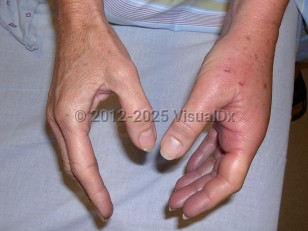Animal bite infection in Adult
Alerts and Notices
Important News & Links
Synopsis

Animal bite wounds and associated infections represent approximately 1% of all patient visits to emergency departments each year. In the United States alone between 2001 and 2003, there were an estimated 4 521 300 mammalian animal bites resulting in 855 000 medical visits per annum. Infection occurs through direct inoculation with the oral flora, and 3%-18% of animal bites go on to become infected. Generally, dog bites represent about 60% of animal bites, and 10%-20% are accounted for by felines.
Dog bites are more common in the summer months. In adults, the bites tend to be on the extremities. In children under the age of 10 years, bites are more commonly on the face and thus tend to be more serious in nature. Cat bites are more common in women and elderly individuals. Infection tends to develop approximately 8 hours postinjury.
While canine and feline bites represent the majority of such injuries, patients may present with a human bite or injuries caused by human teeth. This warrants a slightly different approach to management. These injuries typically occur during a brawl and may result from one party punching another in the face. This is distressing for both parties. Injuries typically affect the metacarpophalangeal joints, and there is a high likelihood of involvement of the tendons. Given the relative tightness of the hand compartments, immediate attention is required. See human bite hand injury.
Typical symptoms and exam findings of any bite seen at presentation include pain, cellulitis, and purulent discharge at the site of the injury. There can be regional adenopathy and fever, and tenosynovitis or osteomyelitis can develop if the wound is in close proximity to deeper structures.
Immunocompromised Patient Considerations:
Patients undergoing chemotherapy or who have any form of immunosuppression have a higher likelihood of a more complicated clinical course. Patients with immunocompromised state, asplenia, or chronic liver disease are at higher risk of developing severe infections with encapsulated organisms (Staphylococcus pneumoniae, Haemophilus influenza, and Neisseria meningitides), Babesia, Ehrlichia, and Capnocytophaga canimorsus. Such patients require immediate emergent attention.
Dog bites are more common in the summer months. In adults, the bites tend to be on the extremities. In children under the age of 10 years, bites are more commonly on the face and thus tend to be more serious in nature. Cat bites are more common in women and elderly individuals. Infection tends to develop approximately 8 hours postinjury.
While canine and feline bites represent the majority of such injuries, patients may present with a human bite or injuries caused by human teeth. This warrants a slightly different approach to management. These injuries typically occur during a brawl and may result from one party punching another in the face. This is distressing for both parties. Injuries typically affect the metacarpophalangeal joints, and there is a high likelihood of involvement of the tendons. Given the relative tightness of the hand compartments, immediate attention is required. See human bite hand injury.
Typical symptoms and exam findings of any bite seen at presentation include pain, cellulitis, and purulent discharge at the site of the injury. There can be regional adenopathy and fever, and tenosynovitis or osteomyelitis can develop if the wound is in close proximity to deeper structures.
Immunocompromised Patient Considerations:
Patients undergoing chemotherapy or who have any form of immunosuppression have a higher likelihood of a more complicated clinical course. Patients with immunocompromised state, asplenia, or chronic liver disease are at higher risk of developing severe infections with encapsulated organisms (Staphylococcus pneumoniae, Haemophilus influenza, and Neisseria meningitides), Babesia, Ehrlichia, and Capnocytophaga canimorsus. Such patients require immediate emergent attention.
Codes
ICD10CM:
W55.81XA – Bitten by other mammals, initial encounter
SNOMEDCT:
399907009 – Animal bite wound
W55.81XA – Bitten by other mammals, initial encounter
SNOMEDCT:
399907009 – Animal bite wound
Look For
Subscription Required
Diagnostic Pearls
Subscription Required
Differential Diagnosis & Pitfalls

To perform a comparison, select diagnoses from the classic differential
Subscription Required
Best Tests
Subscription Required
Management Pearls
Subscription Required
Therapy
Subscription Required
References
Subscription Required
Last Updated:03/23/2021
Animal bite infection in Adult

